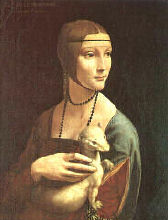Insights to Art
Leonardo's Portrait of a Musician

Leonardo da Vinci, The Musician - Pinacoteca Ambrosiana, Milan

Leonardo da Vinci (attr.) Portrait of a Musician (c.1485; 43cm x 31cm)
Some Doubts Surrounding the Painting
The story of this Portrait of a Musician (also known as The Musician, and referred to in Italian as Ritratto di un musicista, Ritratto di un musico or simply Il musico) was shrouded in mystery for around two hundred years, until it was listed as part of the Ambrosiana collection in 1671. Some lower parts of the portrait are unfinished, there has been some additional painting added during the years, and it is unsigned. Nevertheless experts unanimously include it among Leonardo's works nowadays for stylistic as well as historical reasons. Although this is Leonardo's only remaining portrait of a man, stylistically it bears many similarities with other portraits of his. The typically dark background and very strong contrasts of light and dark of the portrait go hand in hand with features such as the square hand of the figure which is almost identical to that of Cecilia Gallerani in Leonardo's famous portrait commonly known as the Lady with an Ermine (painted around 1483, now in Krakow). The musician's eyes recall those of the Virgin of the Rocks. It is generally assumed that the Portrait of the Musician belongs to Leonardo's early years in Milan and it is often dated around 1485, though it could be as late as the 1490s.

Leonardo da Vinci, Cecilia Gallerani (Lady with an Ermine) (c.1483)
Who is the Musician?
The doubts surrounding the portrait also extend to who the musician may be. Until 1905 when extensive restoration removed some over-painting in the lower half, revealing the sheet of music, the painting was often thought to be a portrait of Duke Ludovico il Moro, Leonardo's benefactor. However, the music led experts to realise that it was in all probability a portrait of one of the court musicians (Leonardo was also a court musician to the Duke, though hardly any of his compositions have survived). Of the three possible names put forward, Josquin des Prez, Franchino Gaffurio and Angelo Testagrossa, the last two seem more likely. Franchino Gaffurio was the Cathedral choirmaster, a composer and a friend of Leonardo's. Leonardo illustrated a practical guide to music written by Gaffurio, who also composed an Angelicum ac divinum opus. The letters "CANT. ANG." on the sheet of music in the painting perhaps suggest Gaffurio's Angelicum. On the other hand, the "CANT. ANG." inscription may indicate Angelo Testagrossa, the Duchess's singing teacher, who Leonardo also knew well.
Leonardo's Ideas on Portrait Painting
In his notebooks, Leonardo suggested that painters should note the faces of people in the street at twilight, particularly when the weather was cloudy or misty - perhaps he was thinking of the common winter fogs in Milan. He felt that people seen in such circumstances had a special attractiveness and softness, and the atmosphere allowed the spectator to gain an insight into the very character of the person, the interior "moto" (moving force) as he called it. He suggested painting portraits in poor light, against a black background to bring out the personality of the sitter. His portraits of Cecilia Gallerani (the Lady with an Ermine) and his Musician are perfect examples of his putting such theories into practice. The figures seem to emerge from a rather gloomy background, almost larger than life and full of character. Even his later works, including the Virgin of the Rocks and his Mona Lisa, demonstrate a very similar approach; his Last Supper also puts great emphasis on human character.
A Musician Full of Character
Many a similar static, immobile portrait done by a lesser painter would probably seem characterless and empty. Leonardo's musician, however, is strangely, humanly tense and immobile, full of expression. And the figure seems all the more real as it emerges from the painting through Leonardo's use of dark and light, particularly the strong shading effects on the face. The musician is obviously concentrating on his music, perhaps composing or learning it, perhaps reading it silently, perhaps preparing to perform it. His fixed, distant stare is almost lost in space, but this belies his concentration. Leonardo has avoided painting a banal portrait of a musician looking down at the music and instead has given us the opportunity to look into the young man's eyes, to look into his soul.
© Nigel J. Ross, 2003
Home |
Publications |
Dictionaries |
English Lang. |
Art Insights |
Travel |
Links | ||||||